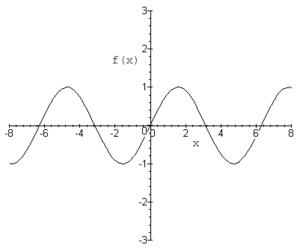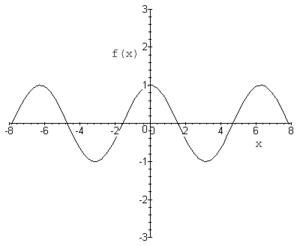| (One intermediate revision by the same user not shown) | |||
| Line 1: | Line 1: | ||
= Periodic versus non-periodic function= | = Periodic versus non-periodic function= | ||
| − | As part of the [[Homework_1_ECE301Fall2008mboutin|first homework]] in [[ECE301]] this semester, we were asked to give an example of a periodic function as well as an example of a non-periodic function. Here are my answers. A precise definition of periodic function can be found on my colleague [[HW1.4_Brian_Thomas_-_Periodic_Versus_Non-Periodic_Signals_in_Discrete_Time_ECE301Fall2008mboutin|Brian Thomas' page]]. | + | As part of the [[Homework_1_ECE301Fall2008mboutin|first homework]] in [[ECE301]] this semester, we were asked to give an example of a periodic function as well as an example of a non-periodic function. Here are my answers. A precise definition of periodic function can be found on my colleague [[HW1.4_Brian_Thomas_-_Periodic_Versus_Non-Periodic_Signals_in_Discrete_Time_ECE301Fall2008mboutin|Brian Thomas' page]]. An animated example can be found on [[HW1.4_Ben_Laskowski_-_Periodic_and_Non-Periodic_Functions_ECE301Fall2008mboutin|this page]]. |
| + | |||
| + | <span style="color:green"> Read the instructor's comments [[hw1periodicECE301f08profcomments|here]]. </span> | ||
== Periodic Functions == | == Periodic Functions == | ||
A periodic function is a function which repeats over a period of time. A good example of periodic functions are: | A periodic function is a function which repeats over a period of time. A good example of periodic functions are: | ||
:*<math>\,y = sin(t)</math> | :*<math>\,y = sin(t)</math> | ||
| − | [[Image:Oddsinx_ECE301Fall2008mboutin.gif]] | + | [[Image:Oddsinx_ECE301Fall2008mboutin.gif|300px]] |
| + | |||
As you can see, this function repeats itself with a period of <math>2\pi</math> | As you can see, this function repeats itself with a period of <math>2\pi</math> | ||
| + | |||
:*<math>\,y = cos(t)</math> | :*<math>\,y = cos(t)</math> | ||
| + | |||
| + | [[Image:Evencosx_ECE301Fall2008mboutin.gif|300px]] | ||
| + | |||
As you can see, this function repeats itself with a period of <math>2\pi</math> | As you can see, this function repeats itself with a period of <math>2\pi</math> | ||
| − | |||
== Non-Periodic Functions == | == Non-Periodic Functions == | ||
Latest revision as of 06:10, 14 April 2010
Periodic versus non-periodic function
As part of the first homework in ECE301 this semester, we were asked to give an example of a periodic function as well as an example of a non-periodic function. Here are my answers. A precise definition of periodic function can be found on my colleague Brian Thomas' page. An animated example can be found on this page.
Read the instructor's comments here.
Periodic Functions
A periodic function is a function which repeats over a period of time. A good example of periodic functions are:
- $ \,y = sin(t) $
As you can see, this function repeats itself with a period of $ 2\pi $
- $ \,y = cos(t) $
As you can see, this function repeats itself with a period of $ 2\pi $
Non-Periodic Functions
Non periodic functions don't repeat. A good example of non-periodic functions are:
- $ \,y = x^2 $
- $ \,y = e^x $





